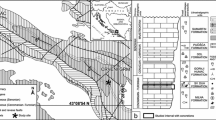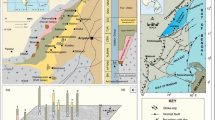Abstract
Concretions, with abundant calcite-dolomite cement-replacement textures originally hosted in shallow-marine sandstones, were reworked into Lower Cretaceous fluvio-deltaic conglomerates and shoreface sandstones (External Zones, Betic Cordillera). A cycle of host sand deposition, early diagenetic concretion formation and concretion reworking is documented: (1) Well-sorted shoreface sandstone deposited. (2) Spherical to ovoid, non-ferroan calcite-cemented concretions formed below flooding surfaces at shallow-burial depths during early eodiagenesis. Non-ferroan calcite cements were precipitated from the bicarbonate derived from seawater and from dissolution of marine bioclasts, as shown by isotope analyses. (3) Concretions were reworked and exposed on the seafloor in a high-energy setting as indicated by the presence of numerous bivalve borings (Entobia ichnofacies), laminated micritic microbial crusts around the concretions, and epilithobionts (oysters, barnacles and corals) on the concretion surface. Concretions also appear as erosional remnants on the floor of channels which were incised into the shoreline sandstone when sea-level fell. (4) The fluvio–deltaic channels were filled with sediment during flooding in the late lowstand of sea-level. (5) The concretions are partly dolomitized, and the presence of siderite, pyrite and barite in the outer part of the concretions precipitated before the dolomite, suggests that the latter formed during shallow burial.











Similar content being viewed by others
References
Abdel-Wahab A, McBride EF (2001) Origin of giant calcite-cemented concretions, temple member, Qasr El Sagha Formation (Eocene), Faiyum depression, Egypt. J Sediment Res 71:70–81
Al-Aasm IS, Taylor BE, South B (1990) Stable isotope analysis of multiple carbonate samples using selective acid extraction. Chemical Geol 80:119–125
Baird GC (1976) Coral encrusted concretions: a key to recognition of a ‘shale on shale’ erosion surface. Lethaia 9:293–302
Berner RA (1968) Rate of concretion growth. Geochim Cosmochim Acta 32:477–483
Bhattacharya JP, Willis BJ (2001) Lowstand deltas in Frontier Formation, Powder River basin, Wyoming: implications for sequence stratigraphic models. Am Assoc Petrol Geol Bull 85:261–294
Bjorkum PA, Walderhaug O (1990) Geometrical arrangement of calcite cementation within shallow marine sandstones. Earth Sci Rev 29:145–161
Bromley RG, Asgaard U (1993) Endolithic community replacement on a Pliocene rocky coast. Ichnos 2:93–116
Budd DA, Hammes U, Ward WB (2000) Cathodoluminescence in calcite cements: new insights on Pb and Zn sensitizing, Mn activation, and Fe quenching at low trace-element concentrations. J Sediment Res 70:217–226
Catuneanu O, Galloway WE, Kendall ChG, St C, Miall AD, Posamentier HW, Strasser A, Tucker ME (2011) Sequence stratigraphy: methodology and nomenclature. News Stratigr 44(3):173–245
Coniglio M, Myrow P, White T (2000) Stable carbon and oxygen isotope evidence of cretaceous sea-level fluctuations recorded in septarian concretions from Pueblo, Colorado, USA. J Sediment Res 70:700–714
De Gea GA (2004) Bioestratigrafía y eventos del Cretácico Inferior en las Zonas Externas de la Cordillera Bética. Servicio de Publicaciones de la Universidad de Jaén, Jaén
de Gibert JM, Martinell J, Domènech R (1998) Entobia ichnofacies in fossil rocky shores, lower Pliocene, Northwestern Mediterranean. Palaios 13:476–487
Doyle P, Bennett M, Cocks F (1998) Borings in a boulder substrate from the Miocene of southern Spain. Ichnos 5:277–286
Fitzsimmons R, Johnson S (2000) Forced regressions: recognition, architecture and genesis in the Campanian of the Bighorn Basin, Wyoming. In: D Hunt, RL Gawthorpe (eds) Sedimentary response to forced regressions. Geol Soc Lond Special Publ 172:113–140
García-García F, De Gea GA, Ruiz-Ortiz PA (2011) Detached forced-regressive shoreface wedges at the Southern Iberian Continental Palaeomargin (Early Cretaceous, SE Spain). Sediment Geol 236:197–210
Hesselbo SP, Palmer TJ (1992) Reworked early diagenetic concretions and the bioerosional origin of a regional discontinuity within British Jurassic marine mudstones. Sedimentology 39:1045–1065
Kelly SRA, Bromley RG (1984) Ichnological nomenclature of clavate borings. Palaeontology 27:793–807
Kim ST, O’Neil JR (1987) Equilibrium and nonequilibrium oxygen isotope effects in synthetic carbonates. Geochim Cosmochim Acta 61:3461–3475
Krajewski KP, Luks B (2003) Origin of “cannon-ball” concretions in the Carolinefjellet Formation (Lower Cretaceous), Spitsbergen. Polish Polar Res 24:217–242
Lee DE, Scholz J, Gordon DP (1997) Paleoecology of a late Eocene mobile rockground biota from North Otago, New Zeland. Palaios 12:568–3581
Machent PG, Taylor KG, Macquaker JHS, Marshall JD (2007) Patterns of early post-depositional and burial cementation in distal shallow-marine sandstones: upper Cretaceous Kenilworth Member, Book Cliffs, Utah, USA. Sediment Geol 198:125–145
McBride EF, Milliken KL (2006) Giant calcite-cemented concretions, Dakota Formation, central Kansas, USA. Sedimentology 53:1161–1179
McBride EF, Picard MD, Milliken KL (2003) Calcite-cemented concretions in cretaceous sandstone, Wyoming and Utah, USA. J Sediment Res 73:462–483
Rosenbaum J, Sheppard SMF (1986) An isotopic study of siderites, dolomites and ankerites at high temperatures. Geochim Cosmochim Acta 50:1147–1150
Santos A, Mayoral E, da Silca CM, Cachão M, Domènech R, Martinell J (2008) Trace fossil assemblages on Miocene rocky shores of southern Iberia. In: Wisshak M, Tapanila L (eds) Current developments in bioerosion. Springer, Berlin, pp 431–450
Santos A, Mayoral E, Bromley RG (2011) Bioerosive structures from Miocene marine mobile-substrate communities in southern Spain, and description of a new sponge boring. Palaeontology 54:535–545
Seilacher A (2001) Concretion morphologies reflecting diagenetic and epigenetic pathways. Sediment Geol 143:41–57
Siggerud EIH, Steel TJ, Pollard JE (2000) Bored pebbles and ravinement surface clusters in a transgressive systems tract, Sant Llorenç del Munt fan-delta complex, SE Ebro Basin, Spain. Sediment Geol 138:161–177
Taylor KG, Gawthorpe RL (2003) Basin-scale dolomite cementation of shoreface sandstones in response to sea-level fall. GSA Bull 115:1218–1229
Taylor KG, Gawthorpe RL, Curtis CD, Marshall JD, Awiller DN (2000) Carbonate cementation in a sequence-stratigraphic framework: upper Cretaceous sandstones, Book Cliffs, Utah-Colorado. J Sediment Res 70:360–372
Taylor KG, Gawthorpe RL, Fannon-Howell S (2004) Basin-scale diagenetic alteration of shoreface sandstones in the Upper Cretaceous Spring Canyon and Aberdeen Members Blackhawk Formation, Book Cliffs, Utah. Sediment Geol 172:99–115
Terry RD, Chilingar GV (1955) Summary of “Concerning some additional aids in studying sedimentary formations,” by M. S. Shvetsov. J Sediment Res 25:229–234
Voigt E (1968) Uber Hiatus-Konkretion (dargestellt am Beispielen aus dem Lias). Geol Rundsch 58:281–296
Wanas HA (2008) Calcite-cemented concretions in shallow marine and fluvial sandstones of the Birket Qarun Formation (Late Eocene), El-Faiyum depression, Egypt: field petrographic and geochemical studies: implications for formation conditions. Sediment Geol 212:40–48
Wilkinson M, Dampier MD (1990) The rate of growth of sandstone-based calcite concretions. Geochim Cosmochim Acta 54:391–399
Zaton M (2010) Hiatus concretions. Geol Today 26:186–189
Acknowledgments
This research was supported by the projects CGL2009-10329, CGL2009-07830/BTE, CGL2009-05768-E/BTE, CGL2007-65832/BTE and CGL2010-15372 financed by the Spanish Ministry of Education and Science (MEC), the European Foundation of Regional Development (FEDER), and Research Group RNM-200 and 316of the Junta de Andalucía. R. Marfil was supported by Project UCM-CAM CCG07-UCM-AMB 2299. Grupo 910404 “Petrología Aplicada al análisis de cuencas y a la conservación del Patrimonio Geológico”. A. Santos received financial support from the Ministry of Science and Technology of Spain in the form of a Juan de la Cierva contract (Refª JCI-2008-2431). D. Daniel Garcia from the Centre SPIN, Departement GENERIC, Ecole Nationale Superieure des Mines des St. Etienne, France is gratefully acknowledged for studying the samples under cathodoluminescence microscopy. Stable isotopes analysis was carried out in Instituto Andaluz Ciencias de la Tierra (CSIC). We are indebted to Eugenio Baldonedo Rodriguez and Alfredo Larios for their valuable help with the SEM and EMPA analyses respectively. Christine Laurin is thanked for the English version of the text.
Author information
Authors and Affiliations
Corresponding author
Rights and permissions
About this article
Cite this article
García-García, F., Marfil, R., De Gea, G.A. et al. Reworked marine sandstone concretions: a record of high-frequency shallow burial to exhumation cycles. Facies 59, 843–861 (2013). https://doi.org/10.1007/s10347-012-0335-z
Received:
Accepted:
Published:
Issue Date:
DOI: https://doi.org/10.1007/s10347-012-0335-z




